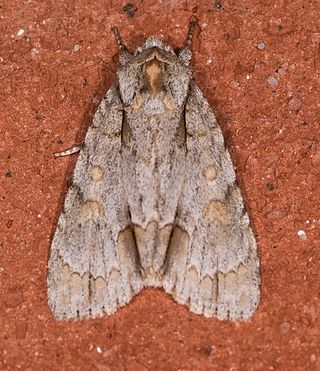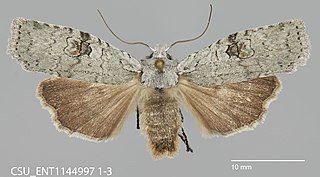
The miller is a moth of the family Noctuidae. It is found throughout Europe apart from the far south-east. The range extends from the South of Spain, Central Italy and Bulgaria to Scotland and Central Scandinavia, crossing the Arctic Circle in Finland and Norway. Outside Europe it is only known in North Africa. In the Eastern Palearctic and the Nearctic realm it is replaced by Acronicta vulpina, formerly known as Acronicta leporina subspecies vulpina.

The grey dagger is a moth of the family Noctuidae.

Acronicta is a genus of noctuid moths containing about 150 species distributed mainly in the temperate Holarctic, with some in adjacent subtropical regions. The genus was erected by Carl Linnaeus in his 1758 10th edition of Systema Naturae. Caterpillars of most Acronicta species are unmistakable, with brightly colored hairy spikes, and often feed quite visibly on common foliate trees. The hairy spikes may contain poison, which cause itchy, painful, swollen rash in humans on contact. The larva of the smeared dagger moth is unusually hairy even for this genus. Acronicta species are generally known as dagger moths, as most have one or more black dagger-shaped markings on their forewing uppersides. But some species have a conspicuous dark ring marking instead.

Acronicta americana, the American dagger moth, is a moth of the family Noctuidae. It was originally described by Thaddeus William Harris in 1841 and is native to North America.

Hemaris gracilis, the slender clearwing or graceful clearwing, is a moth of the family Sphingidae. The species was first described by Augustus Radcliffe Grote and Coleman Townsend Robinson in 1865.

Acronicta lanceolaria, the lanceolate dagger moth or pointed dagger, is a moth of the family Noctuidae. The species was first described by Augustus Radcliffe Grote in 1875. It is found in North America, from Nova Scotia to British Columbia. It is listed as a species of special concern and believed extirpated in the US state of Connecticut.

Acronicta lepusculina, commonly known as the cottonwood dagger moth, is a species of moth in the family Noctuidae. The species was first described by Achille Guenée in 1852. It is found in most of eastern North America, west through southern Canada to Vancouver Island and southward.

Acronicta morula, the ochre dagger moth, is a moth of the family Noctuidae. The species was first described by Augustus Radcliffe Grote and Coleman Townsend Robinson in 1868. It is found from Saskatchewan to Nova Scotia, south to Florida, west to Texas.

Acronicta sperata, the hopeful dagger moth, is a moth of the family Noctuidae. The species was first described by Augustus Radcliffe Grote in 1873. It is found in North America from New Brunswick west to the Alberta foothills, south to the District of Columbia, Missouri and in the mountains to Colorado.

Acronicta fragilis, the fragile dagger moth, is a moth of the family Noctuidae. The species was first described by Achille Guenée in 1852. It is found in North America from Newfoundland to Florida, west across Canada, south to Kentucky and Minnesota. It is listed as a species of special concern in the US state of Connecticut.

Acronicta impressa, the impressive dagger moth or willow dagger moth, is a moth of the family Noctuidae. The species was first described by Francis Walker in 1856. It is found from western Canada to north-western Mexico.

Acronicta interrupta, the interrupted dagger moth, is a moth of the family Noctuidae. The species was first described by Achille Guenée in 1852. It is found across southern Canada south of the boreal forest, from New Brunswick west to eastern Alberta, south to Georgia, Nebraska and Arizona.
Acronicta vulpina, the vulpina dagger moth or miller dagger moth, is a moth of the family Noctuidae. The species was first described by Augustus Radcliffe Grote in 1883. It is found in North America from New York and Newfoundland west to central British Columbia, south to Colorado.

Acronicta funeralis, the funerary dagger moth or paddle caterpillar, is a moth of the family Noctuidae. The species was first described by Augustus Radcliffe Grote and Coleman Townsend Robinson in 1866. It has a scattered distribution. It is found in North America from Manitoba to Nova Scotia, south to Maryland. It is also found in Georgia, Mississippi, Texas, and along the west-coast from California to British Columbia.

Acronicta heitzmani, or Heitzman's dagger moth, is a moth of the family Noctuidae. The species was first described by Charles V. Covell and Eric H. Metzler in 1992. It is found in Missouri, Arkansas, Illinois and Ohio.

Acronicta vinnula, the delightful dagger moth, is a moth of the family Noctuidae. It is found from Nova Scotia to Florida, west to Texas, north to Wisconsin and Ontario.

Acronicta albarufa, the barrens dagger moth, is a moth of the family Noctuidae. It has a fragmented distribution in North America that includes southern Ontario and Manitoba, New York, New Jersey, Massachusetts, North Carolina, Virginia, Georgia, Oklahoma, Missouri, Arkansas, and Colorado. It may also be present in Ohio, Pennsylvania, Connecticut, mainland New York and New Mexico. It has been suggested that populations in the south-western United States may be a separate species. It is listed as a species of special concern and believed extirpated in the US state of Connecticut.

Acronicta lupini, the lupine dagger or little bear, is a moth of the family Noctuidae. The species was first described by Augustus Radcliffe Grote in 1873. It is found from Quebec, Newfoundland and Labrador, British Columbia, Alberta and Yukon in Canada, south to California.

Acronicta insita, the large gray dagger or fingered dagger, is a moth of the family Noctuidae. The species was first described by Augustus Radcliffe Grote in 1874. It is found from Newfoundland west to the Pacific coast and Vancouver Island and Haida Gwaii, British Columbia, south to North Carolina and Colorado.

Lithophane viridipallens, the pale green pinion moth, is a moth of the family Noctuidae that is native to North America. It is listed as a species of special concern in the US state of Connecticut. It was described by Augustus Radcliffe Grote in 1877.














